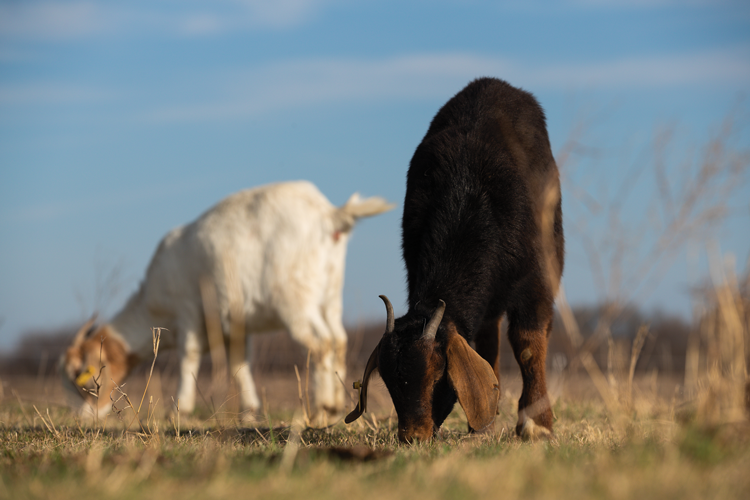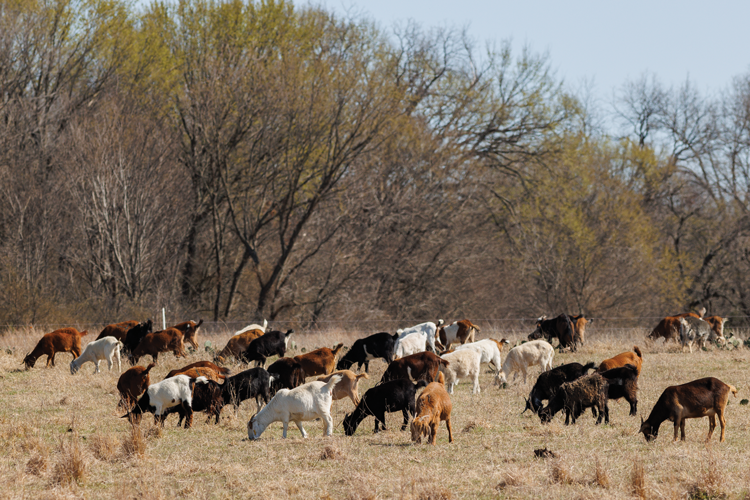Hugh Aljoe is the director of producer relations and Kevin Lynch is a research associate in the research services group, both at Noble Research Institute in Ardmore, Okla.

In this article, we’ll answer several frequently asked questions by producers who have previously only run cattle, with Hugh Aljoe speaking about experiences on Noble Ranches and Kevin Lynch sharing what he’s learned during 35 years of raising small ruminants along with cattle and bison.
Why should a cattle producer consider adding small ruminants to their grazing operation?
Aljoe: When transitioning to regenerative grazing and cutting back on chemical inputs, it’s critical to diversify your livestock. You can utilize much more of your rangeland with sheep and goats than with cattle alone, and the small ruminants control, to a large extent, weed and brush problems and fertilize the soil differently than the cattle do. By grazing multiple species and managing your grazing, you’ll have more plant species being utilized as forages, a different dynamic, and the ecosystem will respond with desirable grass species emerging, which benefits the cattle.
Lynch: You can even benefit from adding sheep on a monoculture of bermudagrass because they graze the grass differently than cattle. Plus, if you stop spraying herbicides, you’ll have all the forbs you want for the sheep while they’re taking care of your weeds. Goats like to browse, so they help keep woody species from encroaching on grasslands. If you have a lot of brush and you start grazing goats, you’ll see a difference in only about 60 days.
When it comes to fertilization, what’s different about sheep and goats versus cattle and/or commercial fertilizer?
Aljoe: The forbs and woody plants that the small ruminants graze aren’t typically plants that get cycled through the cattle. Many times, the forbs, in particular, are rich in some of the nutrients, especially micronutrients, that you don’t observe in grasses. Plus, we’ve noticed that the pellet distribution is more uniform and broader than you have with cow piles. The pellets break down a lot quicker than cow manure, and the nutrients they provide are more readily available than inorganic forms. So, these natural soil amendments are giving you different nutrients, ones that are normally in low quantities at the soil surface.
Will sheep and goats compete for grass forage, causing you to change cattle stocking rates?
Aljoe: You can run one sheep or goat (depending on the plant types in your landscape) per every animal unit of cattle that you’re running and never have a substitution effect on your stocking rate. So, they’re like free animal units you get to graze. With us looking to change our ranch ecosystems back to true savanna grassland with intermittent trees, we may even run two sheep or goats for every cow to get the ecosystem results we need.
Lynch: With goats grazing and browsing woody species, you could go even higher than one-to-one because most times the cows are not grazing those areas preferred by the small ruminants. Plus, sheep and goats usually aren’t grazing the same species as the cattle. They will start eating grass sometimes, but they have a variety of eating habits and change what they graze or browse every day. Sheep and goats use their prehensile lips to pick and choose, taking just a leaf or two off a luscious forb or woody plant and going on to the next one. They might take a bit of tender grass when it first comes up. They are very selective of the plants parts they eat and seem to choose a great variety of plants throughout each grazing event.
What type of sheep and goats are best suited for multispecies grazing?
Lynch: Hair sheep have a lot of advantages over wool sheep for grazing — they’re hardy and low-maintenance; you don’t have to provide sheds or cover for them; you can keep them in with a single hot wire (versus permanent fencing for wool sheep); and it takes only five months to have a lamb that you can then market about 90 days after birth at 50 to 60 pounds.
Here in Oklahoma, I think the best four breeds are Katahdin, Dorper, Royal White, and St. Croix. For goats, I like to go with Spanish, Kiko, Savanna, and TexMaster. We use Dorper hair sheep and Spanish and Kiko goats on the Noble Ranches because they’re parasite resistant and low maintenance. And, amazingly, the Spanish goats can browse brush up to 7 feet above the ground.
What is different about running small ruminants on a ranch? What do you have to add for infrastructure?
Several key things are different and will need to be accommodated:
Guardian dogs (or a jenny donkey or llama) are needed to protect small ruminants from predators such as coyotes and bobcats. With an open landscape, one guardian dog is needed for each 100 ewes or nannies; for hilly land with woods, use one dog for every 50. The dogs will need food on-site, preferably in a portable feeder that can be moved as you rotate grazing paddocks.
Separate water troughs. Sheep and goats don’t prefer to drink from a large tank or pond because they don’t like their feet to get muddy, but they drink only about 1.5 gallons per day, so a small portable water system works best.

Electric fencing needs to be set up specific to the species. Hair sheep can be kept in with one hot wire, but it needs to be at nose-height (about 14 to 16 inches) when the ewes are walking, which is lower than a single wire would be for grazing cattle. Goats need three hot wires to keep them in. It can be polywire, which is easiest for temporary fencing when rotating grazing paddocks. Keeping sheep and goats happy with plenty of their favorite forage to graze is the best way to keep them from roaming.
Graze sheep/goats separately from the cattle. When starting out, cattle, especially mature cows that have not been raised with guardian dogs and small ruminants previously, will not appreciate what the guardian dogs are trying to do. At Noble, with our adaptive grazing, much of the year we let the cattle graze an area first, and then the sheep and goats come in behind and pick out what they want. In the spring, we try to leave the sheep or goats in for only a few days so they don’t switch from forbs to the new grass and set it back.
Working facilities will require retrofitting for sheep and goats. It is not necessary to purchase or build a separate facility for small ruminants. Typically, a cattle-working facility can be easily retrofitted to accommodate sheep and goats by adding net wire or livestock panels (with close-spaced wires) around the perimeter and along crowding areas.
How would you recommend starting out with small-ruminant grazing?
Lynch: I would start with one species — sheep or goats, buying either bred ewes or bred nannies so that you have income from the offspring right away. Buy them from someone who has been running electric fencing, so they are already trained to respect a hot wire. As you would expect, the sheep are easier to manage than the goats.
Overall, what are the biggest benefits from multispecies grazing?
- You get to add an enterprise that will pay for itself in two or three years, and one that’s not difficult to manage, if you’re already doing a good job with your cattle and grazing programs.
- The small ruminants are grazers that complement and do not detract from your main cattle enterprise.
- Sheep and goats provide cycling of additional soil nutrients, which are better allocated across the landscape.
- You’re turning the problems of weeds and brush encroachment into a financial asset — they become a natural resource used to make money.
- You have the opportunity to get closer to the original ecosystem on the prairies when elk, mule deer, and antelope grazed alongside the bison. They likely used different forages and contributed nutrients in a variety of ways, fostering lush native forages and healthy soils.
This article appeared in the March 2023 issue of Hay & Forage Grower on page 26-27
Not a subscriber? Click to get the print magazine.

